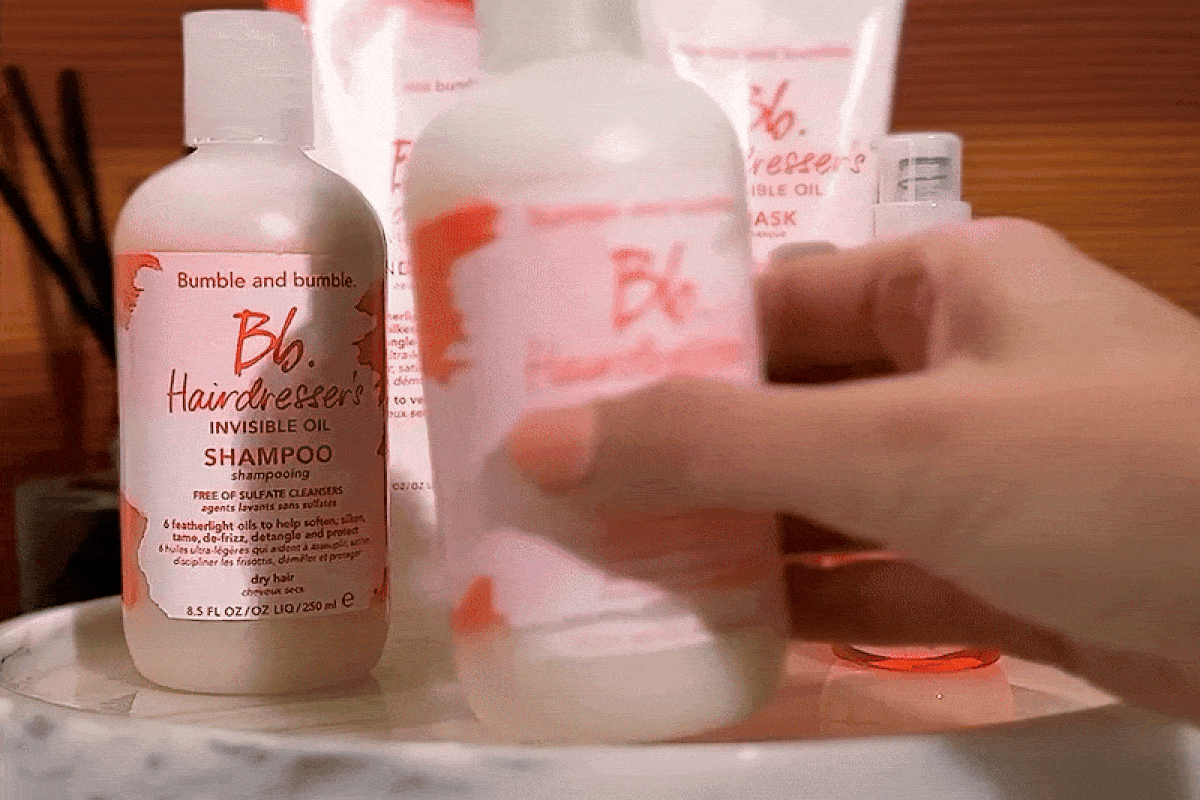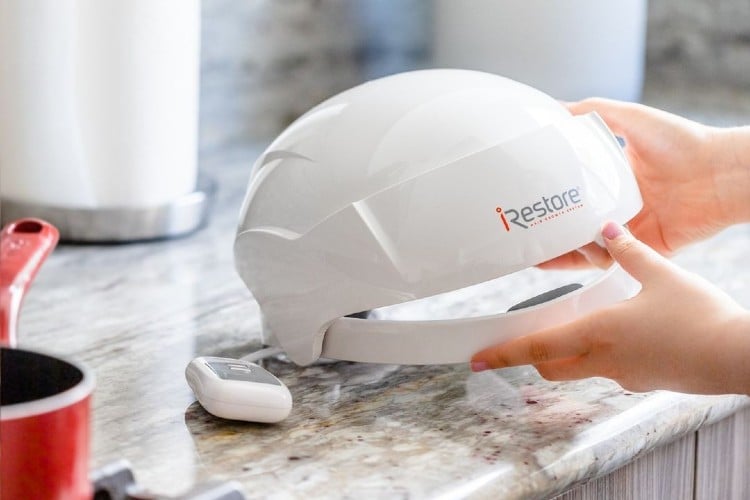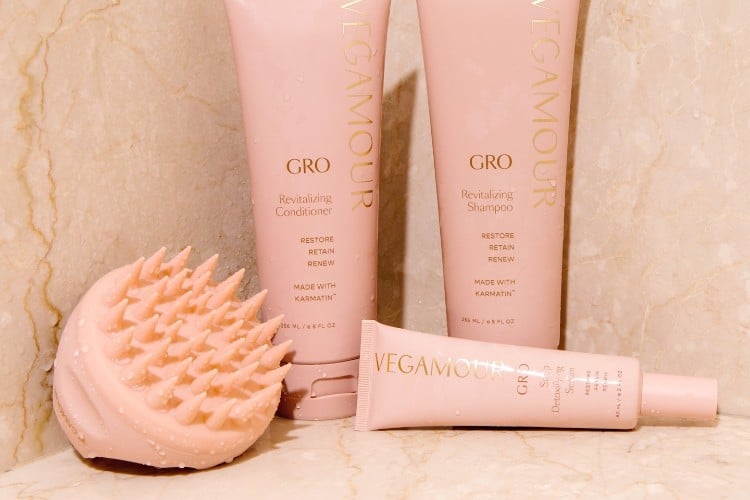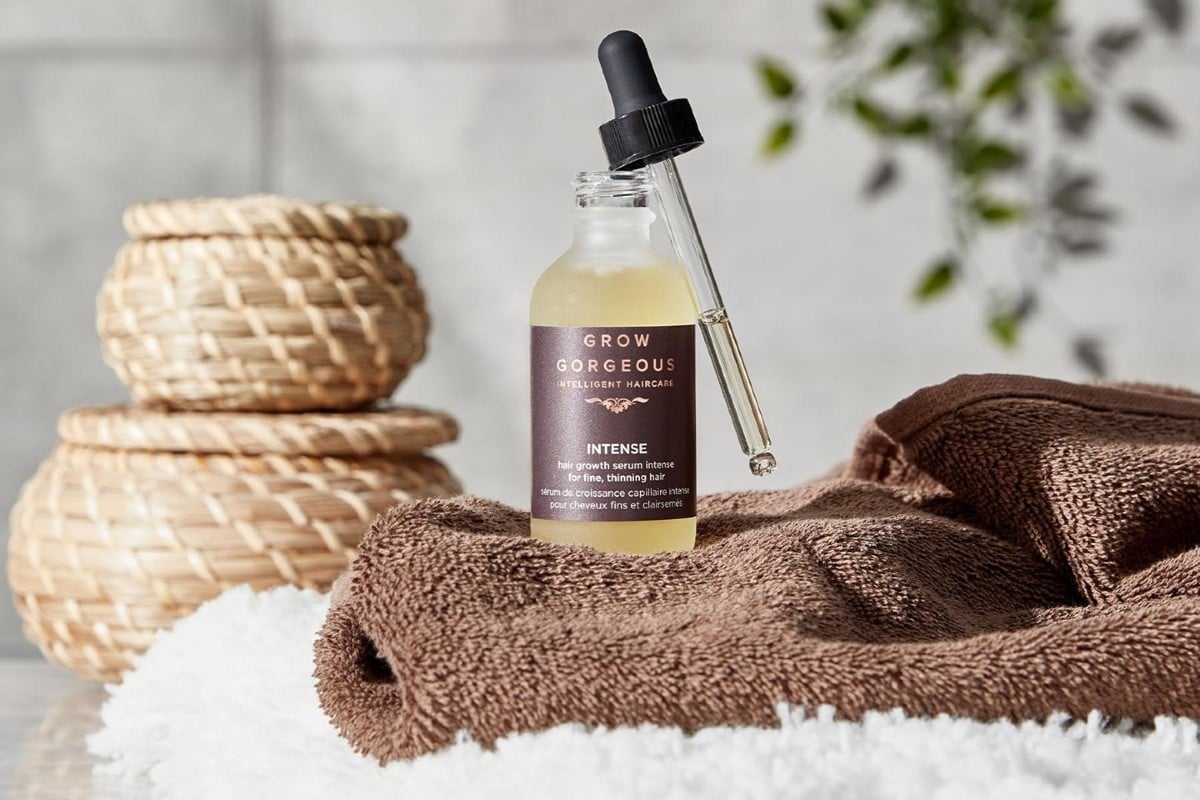Laser treatments have been game-changers in the dermatological field for the past decades and appear to be one of the most demanded (and under-the-radar) solutions for stimulating hair growth. The cutting-edge treatment is technically called low-level laser therapy (LLLT), and its ability to encourage hair production in people suffering from various forms of alopecia has been heavily researched. The best part? LLLT can be easily done in the comfort of your own home without professional attention or time for recovery.
Here you can arm yourself with all the facts surrounding laser hair growth treatments and what you should expect from them.
What is laser hair growth treatment?
Laser hair growth treatment uses low-level lasers to emit light energy into the scalp tissues and feed the weak hair follicles.[1] Once the follicles absorb the energy, the body triggers biochemical reactions (similar to photosynthesis in plants) that support the natural hair growth process. This procedure is called low-level laser therapy (LLLT), and its hair-stimulating effects were first discovered by Endre Mester in 1967.[2] Eventually, LLLT was cleared by the Food and Drug Administration (FDA) in 2007 as a non-surgical treatment for various conditions of alopecia.
On a side note, researchers confirmed that light-emitting diodes (LEDs) could perform as well as lasers for hair treatment. For this reason, LLLT usually uses a combination of low-level lasers and LEDs and is often associated with other terms such as photobiomodulation or light therapy.[3]
How does LLLT stimulate hair growth?
The potential of laser treatment to increase hair growth is primarily correlated with the effects of light energy on stimulating cellular activity in hair follicles. According to research, laser treatment has multiple mechanisms to stimulate hair growth. These include increasing blood flow, reactivating dormant follicles, and reducing inflammation.
Increases blood flow
Light energy can expand the blood vessel in the scalp and increase blood flow, which facilitates the delivery of nutrients to the follicles.[1] As blood circulation increases, follicles receive more nutrients and oxygen required for healthy hair growth. Besides, LLLT increases the production of ATP (adenosine triphosphate), which delivers energy to the hair follicles and stimulates their cellular functions. This is huge news since poor blood flow is often the cause of premature hair shedding.[4]
Reactivates hair follicles
Low-level laser therapy is also assumed to reactivate dormant follicles. Specifically, it pushes the resting follicles to enter the anagen phase, in which the hair is actively growing. In normal hair cycling, about 90% of follicles are in the anagen phase. However, those suffering from hereditary hair loss usually have a reduced duration of the anagen phase. This means the time the hair actively grows is significantly lower.[5] According to studies, light therapy can prolong the anagen phase’s duration and prevents the premature entry of hair follicles into the resting stage.[1]
Reduces inflammation
Another mechanism through which low-level laser treatment supports hair growth is due to its anti-inflammatory effects. It turns out laser energy can reduce the inflammation that weakens the hair follicle.[6] This is especially effective in alopecia areata, an inflammatory condition that causes a sudden and excessive loss of hair.
How effective is it?
Laser hair growth treatment can be very effective in the early stages of alopecia and in cases of thinning hair. Unfortunately, the effectiveness of the treatment decreases with the severity of the condition. The good news, though, is that LLLT can improve the three most common forms of hair loss: androgenic alopecia, alopecia areata, and chemotherapy-induced alopecia.[7] According to a study published by the American Journal of Clinical Dermatology, low-level laser therapy could successfully treat pattern hair loss in both women and men. The short-term results were similar to 5% minoxidil and 1 mg/day finasteride.[8]
Aside from stimulating hair growth, LLLT has proved particularly effective in increasing hair thickness, density, and volume. Interestingly, researchers also add weight to the idea that LLLT can reduce post-treatment shedding and healing time after hair transplant surgery.
How safe is it?
Even though the word laser may sound a bit frightening, the treatment is totally safe and tolerated by most people. The lasers emit low-level energy that doesn’t pose major risks to the user and causes no form of pain or discomfort. Plus, the treatment does not require medical attention or time for recovery. LLLT has been used and clinically researched for more than 50 years and the only adverse effects reported include dry skin, scalp tenderness, and mild irritations in some isolated cases.[1][9] It’s also common to experience slight hair shedding in the first two months of the treatment. This allows stronger and healthy strands to replace the weak ones.
How to perform laser hair growth treatment at home
First, you need to get your hands on a laser hair growth device for home use. They’re available in different formats, including caps, helmets, headbands, and combs, and most of them have FDA clearances for meeting all safety and efficiency parameters. These devices can use either low-level lasers or LEDs (or both) and have been clinically tested to support hair growth and thickness within two to six months. All you have to do is put the device on your head and let it work for about 20 minutes.
Depending on the device, you may need to undergo the treatment between three to five times a week.
How long do laser treatments take to increase hair growth?
Laser hair growth treatment is assumed to increase hair density and reduce shedding within two to four months with regular use, providing the best results after 24 weeks. Most studies reported the first improvements in hair growth after eight weeks. The treatment was used daily or once every two days with sessions of 10-25 minutes.[1]
Can you use laser hair growth treatment with minoxidil?
Good question. Low-level laser treatment was indeed found to provide enhanced benefits in terms of new hair growth when used in combination with minoxidil than when used alone. One clinical study published in 2017 established that using a combination of LLLT and 5% minoxidil significantly increased the number of active hair follicles.[10]
Can you use laser hair growth treatment with finasteride?
Similarly, laser hair growth treatment was found to act synergistically with oral finasteride to enhance hair growth.
The verdict
Based on what is known at this point in time, low-level laser treatment represents a gold standard solution to enhance hair health. As long as your hair is in the early stages of alopecia (whether it is a hereditary or inflammatory condition) or it’s thinning, LLLT is a great option to regrow your hair thicker and healthier.
Footnotes
Women’s Concepts uses reliable sources, including dermatologists’ insights, clinical trials, and scientific journals, to find accurate information and support all the facts shared in our articles. All statements and claims have clear and legit references. Read our editorial policy to learn more about our sources of information, our process of researching and fact-checking the content, and how our team strives to keep all articles updated, completed, and trustworthy.
- Avci P, Gupta GK, Clark J, Wikonkal N, Hamblin MR. Low-level laser (light) therapy (LLLT) for treatment of hair loss. Lasers Surg Med. 2014;46(2):144-151. doi:10.1002/lsm.22170.
- Suchonwanit, P., Chalermroj, N. & Khunkhet, S. Low-level laser therapy for the treatment of androgenetic alopecia in Thai men and women: a 24-week, randomized, double-blind, sham device-controlled trial. Lasers Med Sci 34, 1107–1114 (2019).
- Anders JJ, Lanzafame RJ, Arany PR. Low-level light/laser therapy versus photobiomodulation therapy. Photomed Laser Surg. 2015 Apr;33(4):183-4. doi: 10.1089/pho.2015.9848. PMID: 25844681; PMCID: PMC4390214.
- Klemp P, Peters K, Hansted B. Subcutaneous blood flow in early male pattern baldness. J Invest Dermatol. 1989 May;92(5):725-6. doi: 10.1111/1523-1747.ep12721603. PMID: 2715645.
- Burg D, Yamamoto M, Namekata M, Haklani J, Koike K, Halasz M. Promotion of anagen, increased hair density and reduction of hair fall in a clinical setting following identification of FGF5-inhibiting compounds via a novel 2-stage process. Clin Cosmet Investig Dermatol. 2017;10:71-85. Published 2017 Feb 27. doi:10.2147/CCID.S123401
- Torres, AE, Lim, HW. Photobiomodulation for the management of hair loss. Photodermatol Photoimmunol Photomed. 2021; 37: 91– 98. https://doi.org/10.1111/phpp.12649
- Hamblin MR. Photobiomodulation for the management of alopecia: mechanisms of action, patient selection, and perspectives. Clin Cosmet Investig Dermatol. 2019 Sep 6;12:669-678. doi: 10.2147/CCID.S184979. PMID: 31686888; PMCID: PMC6737896.
- Jimenez, Joaquin J., Tongyu C. Wikramanayake, Wilma Bergfeld, Maria Hordinsky, Janet G. Hickman, Michael R. Hamblin, and Lawrence A. Schachner. 2014. “Efficacy and Safety of a Low-level Laser Device in the Treatment of Male and Female Pattern Hair Loss: A Multicenter, Randomized, Sham Device-controlled, Double-blind Study.” American Journal of Clinical Dermatology 15 (1): 115-127. doi:10.1007/s40257-013-0060-6. http://dx.doi.org/10.1007/ s40257-013-0060-6.
- Egger A, Resnik S, R, Aickara D, Maranda E, Kaiser M, Wikramanayake T, C, Jimenez J, J: Examining the Safety and Efficacy of Low-Level Laser Therapy for Male and Female Pattern Hair Loss: A Review of the Literature. Skin Appendage Disord 2020;6:259-267. doi: 10.1159/000509001
- Esmat, S.M., Hegazy, R.A., Gawdat, H.I., Abdel Hay, R.M., Allam, R.S., El Naggar, R. and Moneib, H. (2017), Low level light-minoxidil 5% combination versus either therapeutic modality alone in management of female patterned hair loss: A randomized controlled study. Lasers Surg. Med., 49: 835-843. https://doi.org/10.1002/lsm.22684





